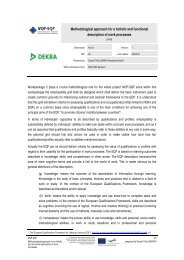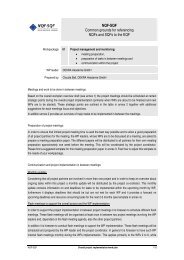Overview of National Qualification frameworks - Project-Nqf-Sqf
Overview of National Qualification frameworks - Project-Nqf-Sqf
Overview of National Qualification frameworks - Project-Nqf-Sqf
You also want an ePaper? Increase the reach of your titles
YUMPU automatically turns print PDFs into web optimized ePapers that Google loves.
The relationships between the State and the Regions concerning the governance and institutional issuesare currently being discussed. On 17 February 2010, an important agreement between Ministry <strong>of</strong>Labour, Regions and Social Partners was signed in relation to the training policies to be jointlyimplemented through the current year. This agreement called Guidelines for Training in 2010 sees thenational qualification system in a wider European context and underlines the key role to be played by alearning outcomes approach in aiding individual learning. Also, recognition <strong>of</strong> non-formal and informallearning has been mentioned within these guidelines as a strategic focus in the perspective <strong>of</strong> humancapital competitiveness and lifelong learning aims.A concrete result <strong>of</strong> the development processes, on the way since 2006, is the recent reform in uppersecondary education introducing new levels defined by learning outcomes and reflecting the EQF leveldescriptors. It introduces three main secondary school pathways: general (lycées), technical andvocational education pathway, leading to five-year diplomas and learning outcomes linked to the EQF.Moreover, the vocational education and training system managed by Regions will operate according toagreed national standards (consistent with the EQF levels). Three-year vocational qualifications andfour-year vocational diplomas will be awarded. The implementation started in September 2010 and willcontinue up to 2013. Levels and level descriptors are seen as important for placing programmes in amore coherent way and to show progression routes between programmes.The Italian education and training system has introduced the learning outcomes approach at national andregional levels, with each subsystem having its own characteristics. The upper secondary educationsystem has recently aligned qualifications and curricula to the EQF learning outcomes structures. InFebruary 2010, the reform regulation <strong>of</strong> the upper secondary education system was adopted. In thevocational training system, where the Regions have the main responsibility, according to the reforms <strong>of</strong>the Italian Constitution (<strong>National</strong> Law No 3, October 2001, concerning Modifications <strong>of</strong> V Title <strong>of</strong>second part <strong>of</strong> Italian Constitution) an update <strong>of</strong> the local qualification system adopting the learningoutcomes approach has been launched. Curricula will be redesigned according to EQF indicator anddescriptors. Three-year vocational qualifications and a four-year vocational diploma will be awarded.The higher (non-academic) pr<strong>of</strong>essional education and training pathway (IFTS) uses a national standardsystem based on competences since 2000. Moreover, after the Decree <strong>of</strong> 25 January 2008, the <strong>National</strong>Committee on IFTS agreed to update the standards to make them more coherent with the learningoutcomes approach. There will be a regional supply <strong>of</strong> training courses in IFTS (one year) and a nationalsupply <strong>of</strong> IFTS courses (two years). The one-year courses are already based on national standards <strong>of</strong>pr<strong>of</strong>iles and competence units <strong>of</strong> learning outcomes; however, they will be implemented in accordancewith the local needs. The two-year courses will soon be based on learning outcomes standards. Inacademic education (universities) the policy-makers strengthened the need to align diplomas andcertificates to the commitments <strong>of</strong> the Bologna process. In particular, the <strong>National</strong> Decree that reformsthe academic system (first cycle, three years) and Laurea Magistrale (second cycle, two years) statesthat the new programmes have to be based on learning outcomes compatible with Dublin descriptors.The enterprises involved in the reform <strong>of</strong> the university system agreed on the learning outcomesapproach, considering it very close to the labour market.4 Quality management / Quality assurance__ Which forms <strong>of</strong> quality management / quality assurance do exist? Which measures are used to avoidmislinkings between the NQF and the EQF?The <strong>National</strong> Table/Committee revealed the need <strong>of</strong> involve a Quality Reference Point to avoidmislinkings between the NQF and the EQF and for the link with the EU guidelines, but nothing has beenyet developed.__ Have you already identified any mislinkings between qualifications within the NQF and the EQF? Ifso, please describe briefly.Page 5/5




